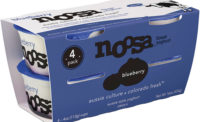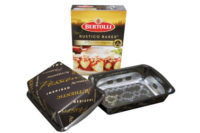The flexible packaging industry is booming - I didn’t even need to tell you that - you know it already. Scour grocery store shelves and you will see more and more flexible containers replacing the rigid ones that long ruled the aisles. I reached out to some big players in the industry and asked why the boom, where the industry is headed and what they hear customers requesting for their packaging. Read on for some insight into this thriving industry.
Meet the contributors:
- Kathy Bolhous, CEO, Charter Nex
- Nestor de Mattos, group marketing director, North America Dow Food & Specialty Packaging
- Roman Forowycz, chief marketing officer/group president, Clear Lam Packaging
- Bruce McKay, vice president of sales, Mondi Americas
- Yasmin Siddiqi, global director, DuPont Packaging
Jump to:
- Displaying flexible packaging
- Wine pouch ignites convenience
- Pouches Create a WOW effect
- Pouches have a strong shelf presence
Food and Beverage Packaging: Why the flexible packaging boom? What spurred it?
Kathy Bolhous: Flexible packaging is now used in a broad range of applications that have historically been in metal cans or plastic bottles. The versatility of flexible packaging allows for it to meet many consumer demands, such as single serve, easy to open, easy to prepare (microwave) and 100% evacuation of the package. The pouch can be customized to various shapes and graphics to promote brand differentiation and to create shelf appeal. The growth of store brands, which are nearly 20% of all retail store products, have driven much of the customization that we see today with flexible packaging. Large global food companies are transitioning to smaller, decentralized groups of “brand” companies, which is also creating demand for differentiation.
Nestor de Mattos: There is a combination of things that have driven the flexible packaging boom. One of those is costs. Flexible packaging has always been a more economical way to deliver goods but the recent technological advances in materials and packaging design has helped enable rapid expansion. Combine that with the sustainability goals of companies and recent consumer trends, and you have a real boom. With many consumers living fast-paced and on-the-go lifestyles, convenience, durability, ease of use, sealability and portability are some of the functions at the top of the list of needs for today’s packaging innovations. Accomplishing any combination of those functions in a package typically requires multiple high performing materials.
Roman Forowycz: Retailers and brand owners are demanding flexible packaging because it can improve product shelf life, reduce package weight, reduce the amount of plastic used and it provides consumers with an impactful product experience in store and at home. Flexible packaging helps control product shelf life through the management of barrier properties like oxygen and vapor transmission rates. Since flexible films are much lighter than pre-formed containers, packages made from film take up less space on a truck and the retail shelf.
Bruce McKay: The reasons for growth in flexible packaging are growing acceptance of flexible formats by consumers. With more built in features to promote convenience, handling and resealability, consumers have been quicker to adopt the new formats. Consumers see less packaging without any loss in functionality.
Yasmin Siddiqi: You can combine different materials to achieve different functionality and get better performance. The result is greater versatility and design freedom. Take convenience, for example: flexible packaging enables conveniences like easy-peel, easy-open, reclosability, oven-ready, pre-cooked. Breakthroughs in better barrier protection for flexible packaging keep food fresher longer. Flexible packaging is also lighter weight than rigid packaging. New technologies, hermetic sealing, new designs – they improve flexible packaging’s ability to protect the contents. These lighter weight packaging alternatives significantly reduce transportation and logistics costs alone. This really helps make products more affordable and that is spurring a lot of growth, especially in developing regions with a growing consumer class.
FBP: Do you see flexible packaging one day replacing more rigid food and beverage containers? Why or why not?
Bolhous: Absolutely! Fitments, spouts and caps are increasing the convenience and functionality of flexible packages and are creating tremendous growth in this format. An example of flexible packaging transforming a segment is the baby food category. Fitments, like spoons, can be added to this food package which increases functionality and convenience. Collaboration between machinery and material suppliers will continue to spark pouch innovation and product proliferation. Multi-national CPG’s are gradually replacing aging assets with flexible packaging alternatives which will contribute to future growth as well.
De Mattos: There is a place for both flexible and rigid packaging but flexible plastic packaging has definitely been able to take advantage of recent trends which have created opportunities for growth. Flexible packaging also has cost advantages that benefit the entire value chain, including the consumer. Lightweighting, reclose, better moisture barrier and sealability are all functions that will not go away, so we believe that flexible packaging will continue to grow.
Forowycz: Flexible packaging has been actively replacing rigid containers and continues to take share. The flexible packaging category is worth $27 billion, per the Flexible Packaging Association. And, it is projected to grow 3.2% annually through 2017 according to 2013 data from a leading research company. Flexible packaging’s ability to reduce package weight and save area (take up less space on trucks and the retail shelf) enables it to take cost out of the supply chain.
McKay: While some conversion will continue where it makes sense, there will be a limit to complete conversion. Rigid formats will still have specific applications and consumer preference. However, lower weight materials and improved design will still contribute to more conversion in the near term.
Siddiqi: The trend to replace rigid food and beverage will continue, but flexible packaging will never completely replace the more rigid containers – there is a need for a wide variety. But flexible packaging will challenge rigid structures in many, many applications. Flexible packaging offers great benefits -versatility, comparative low cost, lightweight and many others.
FBP: What do your customers want regarding their packaging? What benefits does flexible offer them?
Bolhous: First and foremost, consumers want packaging to protect their food, keep it fresh and preserve the flavor. Consumers also want packages that are easy to open and reclose and that allow for 100% of the product to be evacuated from the package.
De Mattos: It’s no secret that packaging manufacturers want their product offerings to be the best in the markets they serve, at the lowest cost to produce. Customers are always seeking materials that can help them reduce costs and increase the benefits of convenience, reliability and sustainability in their packages.
Forowycz: Our customers want packaging that reduces weight, takes up less space on trucks and the retail shelf, uses less plastic and contributes cost savings throughout the supply chain. They also want the shelf impact benefits that printed flexible packaging offers (vs other packaging options) to grab consumer attention.
McKay: The single biggest requirement our customers want are improvements in terms of packaging and logistics (shipping). This is often associated with a sustainability advantage. Beyond this, customers do not want to lose any consumer functionality compared to existing formats or operational efficiency - especially line speeds. If an enhanced consumer experience can be achieved through design (i.e. less pantry or refrigerator space occupied or improved portability and dispensing) then the change is often associated with a gain in sales as well.
Siddiqi: It’s about performance, sustainability and a good value/cost equation. When our customers look holistically at their total system cost, they often realize a good value/cost equation by using higher-performance materials, such as ionomers, instead of lower-cost, more commodity materials in sealant layers because they can maintain desired stiffness, reduce leakers and run faster sealing speeds.
Displaying flexible packaging
Flexible packaging’s rapid success and growth in the market place has spurred the growth of secondary packaging to display and protect these packages. Delkor’s (delkorsystems.com) convertible Cabrio Case performs well as both a shipping case and a retail-ready display for flexible packaging. The shipper opens with a single motion to reveal a clean, shelf-ready tray. The case provides marketing, sustainability and laborsaving benefits. For retailers, the case reduces product damage and stocking time, while increasing the number of facings for the product, for example, shredded cheese in retail dairy cases. The Cabrio Case uses less corrugated board than standard RSC containers, yet it has the structural integrity to ensure product safety during the journey through the supply chain.
Using this case, product is top-loaded and lays flat during shipping, which prevents product settling during shipment. Once opened, the tray offers colorful front-facing branding. It is easy to rotate and stock. There is no cutting, no jagged tears and no worker injuries. Most importantly, the design allows superb display of flat products in flexible packaging.
Wine pouch ignites convenience
Bonfire wines
The Bonfire Wines™ Standup Pouch, from Bemis Curwood, is a 1.5 liter pouch that appeals to the next generation of wine drinkers who make their purchase decisions quickly, emotionally and based on value. The Bonfire Wines pouch has a sleek tapered profile and fashion-driven graphics to differentiate the brand on shelf, while its easy portability, sharable size and one-touch dispensing extend the occasions for enjoyment. The pouch’s flexible film structure, developed for the wine’s unique characteristics, includes an OPET exterior layer, metallized core and Liquiflex® Advance™ inner layer for maximum printability, barrier, strength, stiffness and organoleptic properties. The package’s signature shape—a first in barrel pouches—solves the “sagging” challenge common to liquid packaging. Compared to bottled wine, the pouches offer an 80% smaller carbon footprint over the package life cycle.
Pouches Create a WOW effect
PrimaPak
An example of Clear Lam’s new replacement for bottles, jars and cans is the PrimaPak™ packaging. It’s essentially a “pop-up box” made from flexible rollstock on vertical form-fill-seal machinery. It not a stand up bag, but it is a flexible, stackable and re-sealable container. PrimaPak packaging uses up to 70% less plastic by weight compared to PET jars, reducing warehousing demands and truck shipments while improving costs and enhancing sustainability initiatives. The package provides weight savings, space savings, reduces plastic and removes cost from the supply chain. The package can be produced in a range of custom shapes and sizes.
Pack’Ems
New Pack’Ems, from Booginhead, are reusable snack packs in colorful, cheery designs. Pack’Ems come in both large and small sizes and feature a gusseted bottom for easy, stand-up design. They are easy to open and close with unique VELCRO® brand Press-Lok™ patented material. The packs are made of extra durable, environmentally friendly plastic that holds up through multiple washes and keeps food fresh longer. They are dishwasher-safe, easy-to-clean, BPA, PVC and phthalate-free.
Pouches have a strong shelf presence
Nuvino wine
Nuvino wine is a new line of premium single-serve wine in a pouch from vineyards around the world. The 187ml wines are light, portable, unbreakable and resealable. In addition, there is no need for a tool to open the package. The innovative PreservPak preserves wine for a minimum of 12 months.
“Nuvino is not only convenient for individuals on-the-go, but is also ideal for the hospitality and travel industry, sports and entertainment venues and other recreational facilities that are always seeking for more ways to capture and grow on-premise wine sales,” says Jason Carignan, president of Miravante Brands LLC.
Nuvino is manufactured and distributed under an agreement between Miravante Brands, LLC and Kretek International, a privately-held business that manufactures and distributes products to more than 100,000 convenience stores and the top national retailers in all 50 U.S. states and Canada.
Tate & Lyle sugars
British brand, Tate & Lyle, is being introduced to the US consumer with Fairtrade certified Organic Pure Cane Sugar, Organic Turbinado Raw Cane Sugar and Natural Pure Cane Sugar. The bold colors and engaging graphics of the standup, resealable pouches, from Coating Excellence International (CEI), carry over the premium feeling of the distinct British brands. The standup, re-sealable pouch structure was selected based on its premium presentation and convenience features for consumers. The original graphics were created by Design Bridge in London and were then translated to the US market by enCore Marketing & Design. The US pouch offers different sizes and features than the packaging found in the UK. The new pouches achieve their bold colors and engaging graphics with high quality materials that are #2 recyclable and are widely accepted by many community recycling programs.









